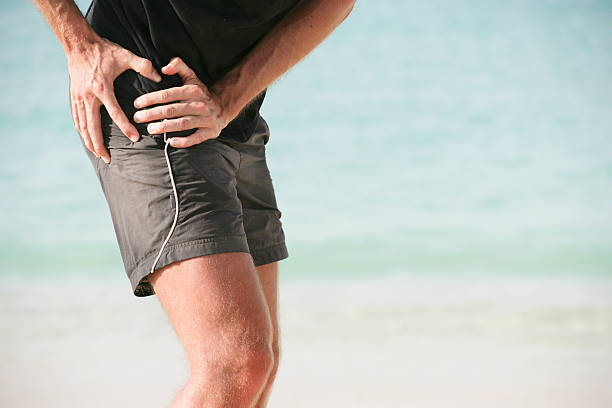Hip pain can be a frustrating condition to live with – walking, sitting, even sleeping can make it worse.
Pain over the side of your hips is a classic symptom of a condition variously known as gluteal tendonitis, trochanteric pain syndrome, lateral hip bursitis, trochanteric bursitis.
Trochanteric bursitis was probably the most common term in the past, although this caused a lot of issues with treatment strategies. That’s because it’s not really an issue with the bursa, or even an inflammatory problem per se (previously people even went as far as having their bursa removed in surgery!). These days, with advances in research, we now recognise the true culprit with most of these cases – the tendon structure in a group of small specialist hip muscles over the side of your hip.
Tendons are like a rope
Lateral hip pain is mostly due to a progressive breakdown in the structure of the tendons of the gluteus medius and/or the gluteus minimus muscle. This is usually driven by local compression, produced by overlapping structures like the “ITB” and the biomechanics of how we use our leg. If you are a runner or have ever been to a massage therapist chances are you have heard of your ITB or Illio-tibial band. In chronic hip pain like this, it produces local compression over these muscle tendons.
Think of your tendons like a rope. Tendons are great at dispersing tensile forces – like the force when you pull on either end of a length of rope. However, they are poorly equipped to handle the compressive load – if you were to step on the same bit of rope and squash it against the floor.
This kind of compressive force over time causes an adaptive change in the tendon substance- where some of your proteoglycans (special stuff that holds fluids in your body) enlarge and thicken to the stage where they disrupt the collagen (the stuff that actually gives tensile strength to the tendon) and hey presto! You have a weak tendon ready for more damage next time you go power walking up hills or sit for a long time with your legs crossed.
Postmenopausal women are the largest group suffering from this condition in my experience. This seems to be related to the fact that oestrogen is important in maintaining the health of your collagen fibres generally and the reduction of it over this time can be a factor in hip pain development. It also seems to be related to women increasing physical activity to combat weight gain associated with this time.
For men, it seems to be common in people who are especially tight generally in their hips and muscles. Running and long walking activities like golf can be driving factors.
How do you know if you have hip pain from tendonitis?
One strong indication is discomfort while sleeping and aching or stiffness when you rise. Many people say it hurts to lie on the bad side, but it also hurts to have it stretched while lying on the good side. When both sides are affected it can make sleeping very difficult.
Walking, particularly up hills, standing on one leg to dress, sitting on low lounges or sitting with legs crossed can all aggravate the condition.
The pain is mostly around the side of the hips but can refer into the groin, buttocks or down into the outside of the leg as far as the knee and sometimes further. It is usually a dull and aching pain, but you can usually find spots around the hip that are painful to press.
About two-thirds of people suffering from it will have back pain or hip arthritis as well.
When you combine this tendency to aggravate the condition by doing something as simple as walking, you can see how this condition gets easily entrenched. It can be very frustrating.
What will an Osteopath do?
It is important to see a professional, particularly if your hip pain has been sticking around over a month. At Sydney Health Professionals, we run diagnostic tests in the clinic to help identify if it is truly lateral hip tendonitis you have, and what the root cause of it might be. We then begin you on a structured program designed to stop the process and correct the underlying causes. This is a very careful process that should be overseen by a professional like an Osteopath, at least at the outset.
As you become more competent in exercising the hip without aggravation, we can then begin to get you to do more and more for yourself at home or in the gym.
Make an appointment today to see one of our Osteopaths and discuss how we can create an individualised plan to get you back to optimum health.

